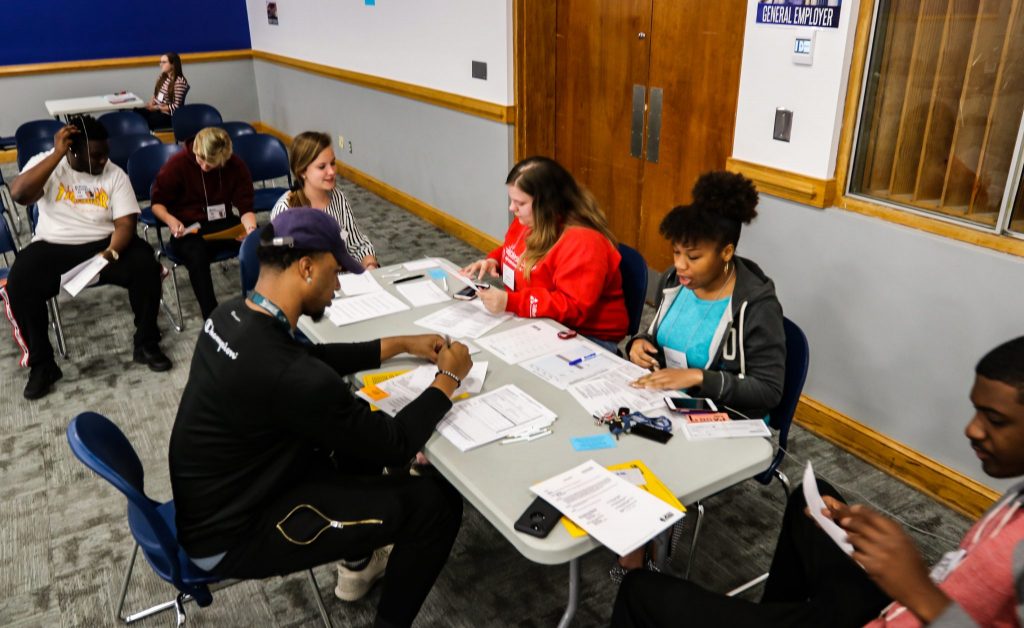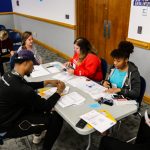Poverty Simulation Teaches Students Real World Challenges

ECSU students participate in a “Poverty Simulation” exercise Tuesday, April 16. The students pictured are gathered at the employment station, providing employment information or applying for jobs. The purpose of the simulation, says Dr. Kacey DiGiancinto, is to give students a glimpse into the lives of people struggling with poverty in the United States.
The poorest among us is quietly working through the system, day-to-day, to survive. That is in brief the message a “Poverty Simulation” exercise is attempting to convey to students.
The Elizabeth City State University Department of Education, Psychology, and Health has been putting students through the paces of poverty and its various effects on people. The hope is, says kinesiology professor Dr. Kacey DiGiacinto, these students will gain a better understanding of what it means to live at or below the poverty line in this country.
“The typical beliefs people have are things like, ‘They just need to work harder,’ or, ‘They just need to try harder,’” explained Dr. DiGiacinto. “So we put the students through all this to let them see what it’s really like.”
All this is a simulation set up inside the K.E. White Center. It consists of various stations representing services and institutions any of us would confront in daily life – banking, grocery shopping, employment, childcare, utilities, education and more.
The simulation – it’s emphasized that it’s a simulation, and not a game – comes from the Missouri Association for Community Action. ECSU psychology professor Dr. Scott Bradshaw says the simulation is one employed across the country and it specifically speaks to ECSU’s expressed desire to have its student population engaged in civic action, as outlined in the University’s Community Action Plan.
The simulation has room for up to 88 participants who assume the roles of up to 26 different families facing poverty.
“Some families are newly unemployed, some are recently deserted by the ‘breadwinner,’ some are homeless, and others are recipients of TANF (Temporary Assistance for Needy Families), either with or without additional earned income,” according to a simulation description. “Still others are senior citizens receiving disability or retirement or grandparents raising their grandchildren. The task of the families is to provide for basic necessities and shelter during the course of four, 15-minute ‘weeks.’”
In short, the students engage in real-world scenarios. These scenarios give them a snap shot at what life at or below the poverty level can be like for some, if not most, people.
Dr. DiGiacinto describes it this way. If you are living at or below the poverty level, you are still strapped with all of the responsibilities of life, yet you are also burdened with the extra challenges of making ends meet while tirelessly managing your time, which is limited because you are spending much of it trying to find basic resources.
You are scrambling to find a job, keep a job, find childcare, get your children to and from school, possibly all while relying on public transportation that may or may not be sufficient, depending upon where you live. And these are only a few of the many challenges that make a life of poverty nearly intolerable for many families.
“They (students) see challenges and it makes them more understanding of what they see in the real world,” said Dr. DiGiacinto.
The students are not only seeing these challenges from the family perspective, but also from the perspective of service providers. Destinee Williams, a junior psychology major, is filling the role of childcare provider. She says it’s a job she does in the real world, and she does see the tremendous impact poverty has on families.
“The disparity between the (socio-economic) lower class and the rest could be fixed,” said Williams.
Demond Holley is a junior kinesiology major. His role is sheriff’s deputy.
“I’m learning how life is not easy,” said Holley.
Dr. Bradshaw and Dr. DiGiacinto pause the action with the blow of the whistle. Each time they do this, it signals that another simulated day or week has passed.
The students move on to their next scenarios, some applying for jobs, while others are applying for assistance, or a loan. The scenarios are never ending, and always challenging. Much like life in poverty itself, and these young adults are seeing those challenges for what they are, difficult.


